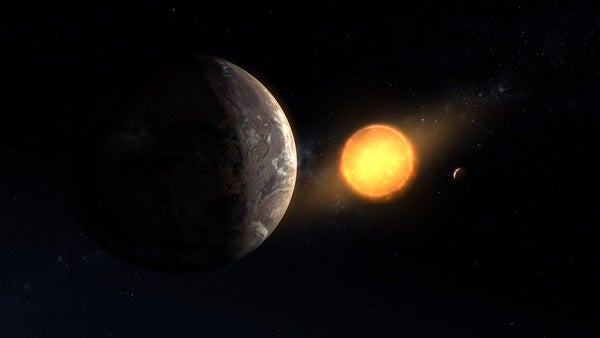A team of scientists has found a new planet that orbits the wrong way around its host star. The planet WASP-17, which orbits a star 1,000 light-years away, was found by the United Kingdom’s Wide Area Search for Planets (WASP) project in collaboration with Geneva Observatory in Switzerland. The discovery casts new light on how planetary systems form and evolve.
Because planets form out of the same swirling gas cloud that creates a star, they are expected to orbit in the same direction that the star spins. David Anderson, from Keele University in the UK, and Amaury Triaud, from Geneva Observatory, were surprised to find that WASP-17 is orbiting the wrong way, making it the first planet known to have a “retrograde” orbit. The likely explanation is that WASP-17 was involved in a near collision with another planet early in its history.
WASP-17 appears to have been the victim of a game of planetary billiards, flung into its unusual orbit by a close encounter with a “big brother” planet. Professor Coel Hellier of Keele University, remarked, “Shakespeare said that two planets could no more occupy the same orbit than two kings could rule England; WASP-17 shows that he was right.”
“Newly formed solar systems can be violent places,” said Anderson. “Our own Moon is thought to have been created when a Mars-sized planet collided with the recently formed Earth and threw up a cloud of debris that turned into the Moon. A near collision during the early, violent stage of this planetary system could have caused a gravitational slingshot, flinging WASP-17 into its backwards orbit.”
The first sign that WASP-17 was unusual was its large size. Although it is only half the mass of Jupiter, it is bloated to nearly twice Jupiter’s size, making it the largest planet known.
Astronomers have long wondered why some extra-solar planets are far bigger than expected, and WASP-17 points to an explanation. Scattered into a highly elliptical, retrograde orbit, it would have been subjected to intense tides. Tidal compression and stretching would have heated the gas-giant planet to its current, hugely bloated extent. “This planet is only as dense as expanded polystyrene, seventy times less dense than the planet we’re standing on,” said Hellier.
“This is a fascinating new find and another triumph for the WASP team,” said Keith Mason, chief executive of the Science and Technology Facilities Council in the UK. “Not only are they locating these far-flung and mysterious planets, but they are revealing more about how planetary systems, such as our own solar system, formed and evolved. The WASP team has proved once again why this project is currently the world’s most successful project searching for transiting exoplanets.”
WASP-17 is the 17th new exoplanet — planet outside our solar system — found by the WASP consortium of UK universities. The WASP team detected the planet using an array of cameras that monitor hundreds of thousands of stars, searching for small dips in their light when a planet transits in front of them. Geneva Observatory then measured the mass of WASP-17, showing that it was the right mass to be a planet. The South African Astronomical Observatory hosted the WASP-South camera array that led to the discovery of WASP-17.










